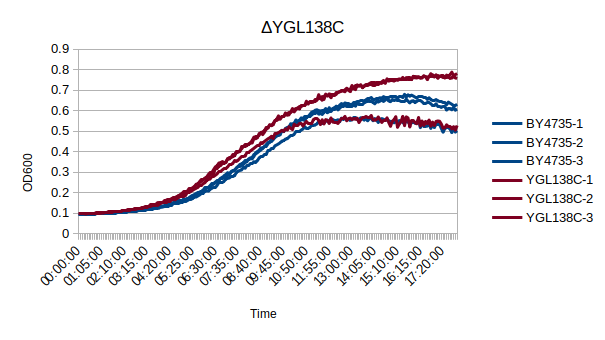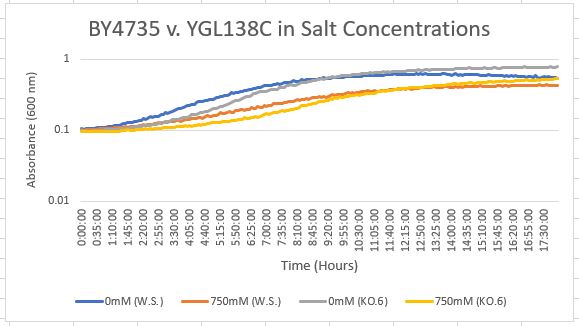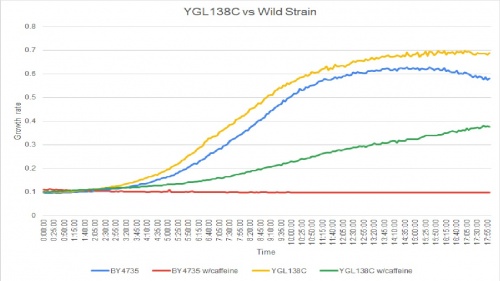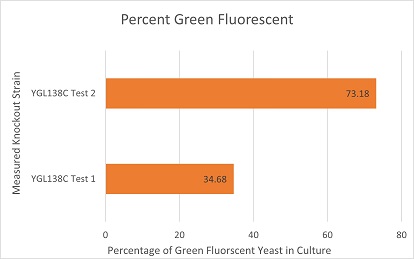Difference between revisions of "YGL138C"
(→Competative Co-culture) |
|||
| Line 83: | Line 83: | ||
===[[UW-Stout/Competitive Co-Culture_SP21|Competative Co-culture]]=== | ===[[UW-Stout/Competitive Co-Culture_SP21|Competative Co-culture]]=== | ||
| + | [[File:YGL138CCompetetiveCoCulture.jpg]] | ||
| + | These are the results of a [[UW-Stout/Co Culture SP21|competitive co-culture]] protocol. The knockout strain was grown in a culture to test fitness against a green, fluorescent wild-type strain. The percentage of analyzed cells in the culture measured was those displaying green fluorescence. In theory, this should mean if a knockout has reduced the fitness of a strain of yeast, the fluorescent wild-type strain would have a higher percentage than the knockout strain. If the knockout does not decrease fitness, they would be roughly equal. This may not be so in results. Sources of error may include contamination and human error. | ||
| + | |||
| + | The results here are expected in theory. The YGL138C knockout strain had a significant disadvantage and the fluorescent wild-type strain dominated the given result. | ||
<protect> | <protect> | ||
Revision as of 11:43, 27 April 2021
Share your knowledge...Edit this entry! <protect>
| Systematic name | YGL138C |
| Gene name | |
| Aliases | |
| Feature type | ORF, Uncharacterized |
| Coordinates | Chr VII:249531..248494 |
| Primary SGDID | S000003106 |
Description of YGL138C: Putative protein of unknown function; has no significant sequence similarity to any known protein[1]
</protect>
Contents
Community Commentary
About Community Commentary. Please share your knowledge!
This gene is part of the UW-Stout Orphan Gene Project. Learn more here.
Growth Curve
In a BY4735 background, knocking out YGL138C does not seem to have much effect on the strain's growth rate. In this assay, the BY4735 strain's doubling time was 162 minutes, while the YGL138C knock-out strain's doubling time was 140 minutes. (These doubling times are the means of three experiments.)
Salt Concentration (NaCl)
0mM NaCl conc. BY4735 strain's doubling time: 169 minutes
0mM NaCl conc. YGL138C strain's doubling time: 139 minutes
750mM NaCl conc. BY4735 strain's doubling time: 294 minutes
750mM NaCl conc. YGL138C strain's doubling time: 205 minutes
The graph above shows the growth rate for the previously listed strains and the relative level of NaCl concentration. Knocking out the gene positively influenced the growth rate. Comparing the YGL138C doubling times in 0mM and 750mM NaCl, there is a moderate effect on the growth rate. This effect negatively impacts the knockout strain's (YGL138C) growth rate.
Caffeine Group 1
When adding caffeine to the YGL138C strain, the effect it had on the growth rate was significant. The doubling times are as follows:
Doubling time of YGL138C with caffeine: 309 minutes
Doubling time of YGL138C without caffeine: 140 minutes
Doubling time of BY4735 with caffeine: -2649 minutes
Doubling time of BY4735 without caffeine: 187 minutes
When adding caffeine to this strain knockout, the growth rate slowed down a great deal.
Competative Co-culture
These are the results of a competitive co-culture protocol. The knockout strain was grown in a culture to test fitness against a green, fluorescent wild-type strain. The percentage of analyzed cells in the culture measured was those displaying green fluorescence. In theory, this should mean if a knockout has reduced the fitness of a strain of yeast, the fluorescent wild-type strain would have a higher percentage than the knockout strain. If the knockout does not decrease fitness, they would be roughly equal. This may not be so in results. Sources of error may include contamination and human error.
The results here are expected in theory. The YGL138C knockout strain had a significant disadvantage and the fluorescent wild-type strain dominated the given result.
<protect>
References
See Help:References on how to add references
See Help:Categories on how to add the wiki page for this gene to a Category </protect>



